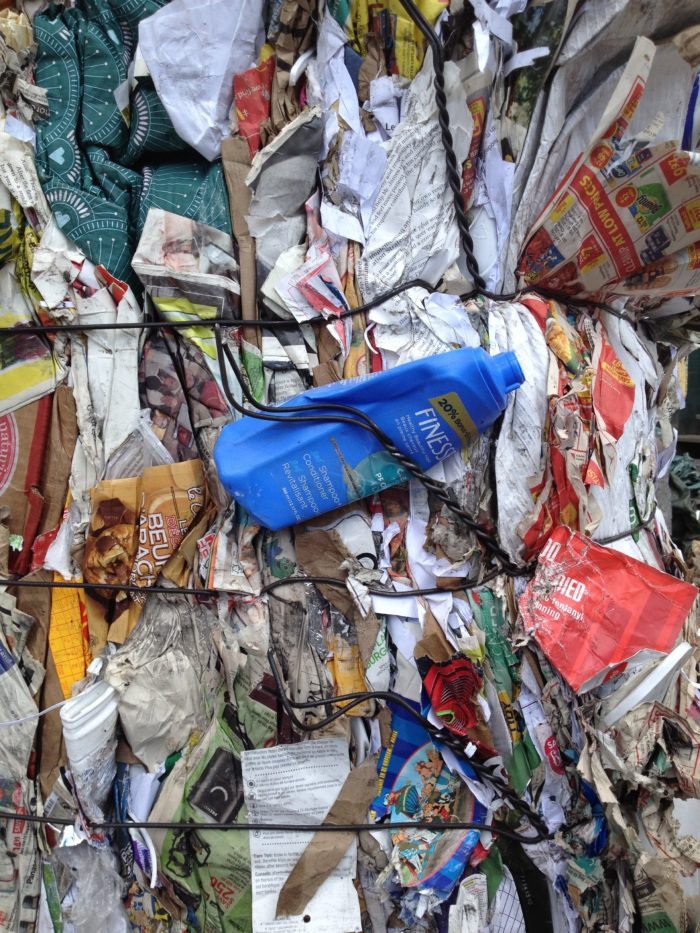I live in an apartment block and whenever I go to empty our recycle bin, the communal bins are overflowing with packaging and containers. It’s great that everybody is taking steps toward protecting the environment, better to recycle than not to—right?
There’s no denying that there is a connection between recycling and reducing climate change. For example, recycling wood and paper products can reduce the need for deforestation. As deforestation is one of the major contributors to the climate crisis, lowering the demand for the production of new materials is fundamental. Greenpeace recently shared that one way of joining the movement to protect forests across the globe is to choose products that are made from recycled and responsibly sourced materials.
But when it comes to recycling, not all materials offer the same amount of benefits. According to National Geographic, 91% of plastics collected for recycling aren’t actually repurposed. So where is all the so-called “recycled” plastics going? I am sure by now you’re all well aware of the vast amount of plastic that is piling up in our rivers and oceans. This is having catastrophic effects on birds, fish, and marine mammals. In fact, a study from last year estimated that there are around eight million metric tones of plastics entering our oceans each year!
In the past few years, governments have finally recognized that the overwhelming influx of recycling cannot be properly processed. This has led many to resort to open-air burning, which worsens both air pollution and climate crisis.
Furthermore, plastics are produced by the petrochemical sector using fossil fuels. So our addiction to plastic isn’t only damaging our wildlife, it’s also giving Big Oil another, significant income stream just as various economies are shifting their focus to renewable energy. The more plastic we purchase, the more fossil fuels are used and the deeper we dig ourselves into climate disaster.
Plastic collected for recycling is also ending up in landfill sites and is even being illegally dumped in developing countries. Greenpeace recently discovered that around 19 countries were responsible for dumping plastic recycling in Malaysia and violating waste disposal regulations.
Although recycling is practiced in many households and is encouraged by local councils and businesses, it is considered a low-priority goal when taking climate crisis into account. So what can sustainable dumplings do to act responsibly? The United States Environmental Protection Agency states that the most effective way to reduce waste, especially plastic, is not to produce it in the first place. The hard truth about plastic is that the vast majority of it is not reusable at all, and that sooner we accept this and focus on not using disposable plastic, the better the world will be.
10 Steps to Reducing Your Waste
- Don’t assume everything you recycle will be recycled. Do some more research into your local recycling depot and ask them some questions, find out exactly what happens to what you are putting in your bins.
- Stop buying the packaging in the first place. We need to lower the demand for pointless packaging such as single-use plastics so that the industry stops creating them. Look for products with minimal packaging and purchase them instead. (Check out all our zero-waste tips!)
- Reuse, recycle and reduce. Try to reuse the packaging you buy and recycle it in your own home. Store dry goods in glass jars or plant flowers in plastic pots.
- Be a conscious shopper. Being really aware of what you are putting into your shopping basket will go a long way in terms of reducing the amount of packaging you are buying. Is there an alternative product with less plastic that you could buy instead?
- Visit zero-waste shops. More and more zero-waste shops are popping up in and around city centers. Take your own packaging with you and top up your shelves without purchasing any packets at all!
- Take shopping bags with you everywhere you go, even if they are made from plastic. Don’t cast away your plastic bags just to replace them with cotton or paper, keep reusing them, and definitely don’t forget them.
- Ditch plastic water bottles. Purchase a good quality water bottle and coffee cup. There are plenty out there made from bamboo, stainless steel and other materials.
- Encourage your friends, family and housemates to work alongside you, work together to create a packaging-free lifestyle.
- Sign petitions. Relating to point 2, it is important we keep putting pressure on the government, industry and large corporations to create and use environmentally friendly packaging. Lobbying your local MP is another great way to do this.
- And finally, try your best. It can sometimes be challenging and overwhelming to live a completely sustainable and environmentally friendly lifestyle, but the key is to take it one step at a time. Not everyone is perfect and we still have a long way to go but at least you can say you are trying and putting in the effort.
There’s no denying that recycling can play an important role in reducing some climate-risk factors. However, it is evident that plastic recycling can often cause more damage than good. Buying products with the intention to recycle the packaging isn’t enough, especially during climate crisis. The truth is that there are too many people on the planet consuming too much. We need to take action into our own hands, make sustainable changes and we need to work together to make one bold statement.
Also by Anna: These 6 Documentaries Convinced Me To Go Vegan (Watch With Your Roommate or Partner!)
Get more like this—Sign up for our daily inspirational newsletter for exclusive content!
__
Photo: Vivianne Lemay via Unsplash





